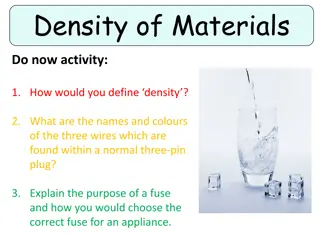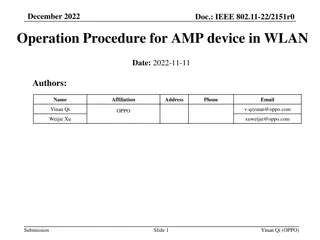Enhancing CSMA/CA Efficiency in High-Density WLAN Deployment
CSMA/CA mechanism in IEEE 802.11 is efficient for low-density WLAN deployment but lacks effectiveness in high-density scenarios. This submission suggests improving spectrum efficiency by shifting contention in the code domain. The aim is to address the performance and user experience in dense deployment settings. The proposal focuses on enhancing contention mechanisms to optimize throughput and reduce interference for both STAs and APs in high-density environments.
Download Presentation

Please find below an Image/Link to download the presentation.
The content on the website is provided AS IS for your information and personal use only. It may not be sold, licensed, or shared on other websites without obtaining consent from the author. Download presentation by click this link. If you encounter any issues during the download, it is possible that the publisher has removed the file from their server.
E N D
Presentation Transcript
doc.: IEEE 802.11-14/0616 May 2014 CSMA Enhancement Suggestion Date: 2014-05-12 Authors: Name Affiliation Address Email Yonggang Fang ZTE yfang@ztetx.com Bo Sun ZTE sun.bo1@zte.com.cn Kaiying Lv ZTE lv.kaiying@zte.com.cn Ke Yao ZTE Ke.yao@zte.com.cn Zhendong Luo CATR luozhendong@catr.cn Meng Yang CATR yangmeng1@catr.cn Slide 1 Submission Yonggang Fang et. al. (ZTE)
doc.: IEEE 802.11-14/0616 May 2014 Abstract CSMA/CA mechanism used in 802.11 is good for low density WLAN deployment. However the use cases that HEW is to address are for high density deployment. In high density deployment cases, the spectrum efficiency of CSMA/CA would be very low and need to be improved. In this contribution, we suggest moving the contention in code domain to improve the efficiency of CSMA/CA mechanism. Submission Slide 2 Yonggang Fang et. al. (ZTE)
doc.: IEEE 802.11-14/0616 May 2014 Background Some HEW Scope and Target From STA point of view Improve performance reflecting user experience increase Per-STA average throughput in dense deployment scenarios; especially the 5th percentile of per station throughput. 4 times improvements for at least one mode of operation From network point of view Improve spectrum efficiency in scenarios of high density of STAs per BSS deployment. Increase frequency reuse and reduce interference in OBSS with high density of both STAs and APs deployment Improve robustness of uplink transmissions. Submission Slide 3 Yonggang Fang et. al. (ZTE)
doc.: IEEE 802.11-14/0616 May 2014 Background CSMA/CA and Effective Contention 802.11 is contention based access technology - CSMA/CA, which is originally designated for single STA to occupy the medium in a fairness way for multiple access. In the contention period, a STA could 1. Successfully transmit a packet, or 2. Collide with other station s transmission, or 3. Not transmit due to backoff procedure. The effective contention Only case 1 is the effective contending the medium. Case 2 and 3 cause the medium waste. Submission Slide 4 Yonggang Fang et. al. (ZTE)
doc.: IEEE 802.11-14/0616 May 2014 Background EDCA Contention Time In order to obtain a transmission opportunity (TXOP), a STA has to sense the medium during contention period: AIFS + CW, where CW: contention widow between aCWmin* and aCWmax * aSlotTime AIFS[AC] = aSIFSTime + AIFSN[AC] x aSlotTime TXOP CW P RTS P A-MPDU SIFS SIFS AIFS SIFS P CTS P BA Contention Period Submission Slide 5 Yonggang Fang et. al. (ZTE)
doc.: IEEE 802.11-14/0616 May 2014 Background EDCA Probability Initial collision probability is Pc = 1 (1 Pt)N-1 The collision probability increases significantly as the number of associated stations reaches a certain level. In order to maintain a lower level probability of collision, CW should be relative large, BUT this causes longer idle time in CW and reduce medium efficiency. If collision occurs, stations have to backoff to wait for longer time before contending the medium, and further reduce the efficiency. Idle time probability in CW Pi = (1 Pt)N Submission Slide 6 Yonggang Fang et. al. (ZTE)
doc.: IEEE 802.11-14/0616 May 2014 Background EDCA Collision Probability [1] analyzes the performance of contention based access, and indicates the collision probability increases significantly as the number of STAs increases. Num. of collisions per successful transmission Prob. Collision 3.50 100% 90% 3.00 80% 2.50 70% 60% 2.00 50% 1.50 40% 30% 1.00 20% 0.50 10% 0.00 0% 0 50 100 150 200 0 50 100 150 200 Number of STAs Number of STAs ?????? ?? ?????????? ????.?? ????????? = ?????? ?????????? + ?????? ?? ?????????? ???????????? Submission Slide 7 Yonggang Fang et. al. (ZTE)
doc.: IEEE 802.11-14/0616 May 2014 Enhancement of CSMA/CA Suggestions Instead of contending the medium in time domain, multiple STAs could contend the medium in code domain. AP in the central control can arbitrate and notify the winning STA(s) for transmission in the next TXOP. The arbitration procedure will help to reduce the probability of collisions. Contention Window idle CA BA Busy AP CTS xIFS SIFS CR STA1 A-PPDU A-PPDU A-PPDU CR STA2 RTS CR STA3 Submission Slide 8 Yonggang Fang et. al. (ZTE)
doc.: IEEE 802.11-14/0616 May 2014 Enhancement of CSMA/CA Advantages of Contending in Code Domain (1) Improve medium usage efficiency Converting the medium contention from time domain to code domain solves medium waste problem caused by increasing contention window size in time domain due to reducing collision probability. In EDCA, the access is randomly deferred in CW: AIFS + Backoff time. When the number of STA is over 30, the collision possibility is > 50%, i.e. one collision per success transmission. That means over 50% CW time are wasted. In addition, the large CW value causes the medium in idle for most of time during the contention period. The medium contention in the code domain will limit the contention window to a fixed time (xIFS + CR + SIFS + CA+SIFS), which will reduce the time of medium in idle or collision and improve the medium usage efficiency. Submission Slide 9 Yonggang Fang et. al. (ZTE)
doc.: IEEE 802.11-14/0616 May 2014 Enhancement of CSMA/CA Advantages of Contending in Code Domain (2) Allow scheduling multiple transmissions in one TXOP Contention in code domain allows AP to identify multiple STAs in contention and arbitrate contention requests. Therefore AP can schedule two or more STAs transmission in one TXOP without further contention. This will help to reduce medium time waste in the contention. TXOP Contention Window idle A-PPDU CA End AP BA ACK CTS Busy xIFS SIFS A-PPDU CR ACK STA1 RTS CR A-PPDU STA2 STA3 Submission Slide 10 Yonggang Fang et. al. (ZTE)
doc.: IEEE 802.11-14/0616 May 2014 Enhancement of CSMA/CA Advantages of Contending in Code Domain (3) Control the collision possibility AP can control and set the space of codes to maintain the possibility that two or more STAs use the same code for contention at a low level, without introducing the backoff delay in the time domain. For example, if we assume the STA gets a CC randomly from the Code Space, then if the code space is set to 128, the collision probability for 30 STAs contending the medium is about 20%. If the code space is increased to 256, the collision probability for 30 STAs contending the medium is about 11%. Another example, if a STA could be assigned a CC by AP instead of randomly selection, then the collision might be avoided. Submission Slide 11 Yonggang Fang et. al. (ZTE)
doc.: IEEE 802.11-14/0616 May 2014 Enhancement of CSMA/CA What Contention Code (CC) to Use CC should be distinguishable and additive AP could be able to distinguish CCs sent from different STAs simultaneously CAZAC (Zadoff-Chu) sequences might be a choice. Originally proposed in IEEE802, now used by 3GPP LTE [2]. In LTE, the random access channel uses sequences generated from one or more root Zadoff-Chu sequences for preamble. Zadoff-Chu sequence has characteristics Zero Autocorrelation. Two sequences generated from the same Zadoff- Chu root sequence (one sequence is shifted from other sequence by N) will have 0 correlation. Cross correlation of two CAZAC sequences is 1/ N, where N is CAZAC code length. Submission Slide 12 Yonggang Fang et. al. (ZTE)
doc.: IEEE 802.11-14/0616 May 2014 Summary Suggestions Introducing the medium contention in code domain to improve the performance of medium usage efficiency, reduce the back-off time and lower collision possibility of CSMA. Considering CAZAC (Zadoff-Chu) sequences as contention code. Studying coexistence with legacy STAs. Slide 13 Submission Yonggang Fang et. al. (ZTE)
doc.: IEEE 802.11-14/0616 May 2014 References 1. 2. 3. 11-13-0505-00-0hew-mac-efficiecy-analysis-for-hew-sg 3GPP TS 36.211 Chu, D. C., Polyphase codes with good periodic correlation properties , IEEE Transactions on Information Theory. Slide 14 Submission Yonggang Fang et. al. (ZTE)























